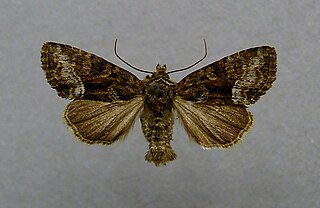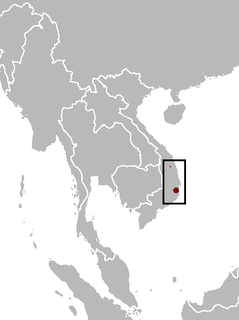
Chevrotains, or mouse-deer, are small even-toed ungulates that make up the family Tragulidae, the only extant members of the infraorder Tragulina. The 10 extant species are placed in three genera, but several species also are known only from fossils. The extant species are found in forests in South and Southeast Asia, with a single species in the rainforests of Central and West Africa. They are solitary or live in pairs, and feed almost exclusively on plant material. Chevrotains are the smallest hoofed mammals in the world. The Asian species weigh between 0.7 and 8.0 kg, while the African chevrotain is considerably larger at 7–16 kg (15–35 lb).

Calotes is a genus of lizards in the draconine clade of the family Agamidae. The genus contains 28 species. Some species are known as forest lizards, others as "bloodsuckers" due to their red heads, and yet others as garden lizards.

The green pheasant, also known as Japanese green pheasant, is an omnivorous bird native to the Japanese archipelago, to which it is endemic. Some taxonomic authorities still consider it a subspecies of the common pheasant, Phasianus colchicus. It is the national bird of Japan.

Tinea versicolor is a condition characterized by a skin eruption on the trunk and proximal extremities. The majority of tinea versicolor is caused by the fungus Malassezia globosa, although Malassezia furfur is responsible for a small number of cases. These yeasts are normally found on the human skin and become troublesome only under certain circumstances, such as a warm and humid environment, although the exact conditions that cause initiation of the disease process are poorly understood.

Hylidae is a wide-ranging family of frogs commonly referred to as "tree frogs and their allies". However, the hylids include a diversity of frog species, many of which do not live in trees, but are terrestrial or semiaquatic.

The silver teal or versicolor teal is a species of dabbling duck in the genus Spatula. It breeds in South America.

Hyla is a genus of frogs in the tree frog family Hylidae. As traditionally defined, it was a wastebasket genus with more than 300 species found in Europe, Asia, Africa, and across the Americas. After a major revision of the family most of these have been moved to other genera so that Hyla now only contains 17 extant (living) species from Europe, northern Africa and Asia. The earliest known fossil member of this genus is †Hyla swanstoni from the Eocene of Saskatchewan, Canada, but its designation to Hyla happened before the major revision, meaning that its position needs confirmation.

The Bonin wood pigeon was a pigeon endemic to Nakodo-jima and Chichi-jima in the Ogasawara Islands, south of Japan. It is known from four recorded specimens, the first from 1827 and the last from 1889. They averaged a length of 45 cm. This pigeon died out late in the 19th century as a result of deforestation, hunting, and predation by introduced rats and cats.

Trametes versicolor – also known as Coriolus versicolor and Polyporus versicolor – is a common polypore mushroom found throughout the world. Meaning 'of several colors', versicolor reliably describes this fungus that displays different colors. For example, because its shape and multiple colors are similar to those of a wild turkey, T. versicolor is commonly called turkey tail. A similar looking mushroom, commonly called false turkey tail, which is from a different order, may sometimes be confused with the turkey tail mushroom due to appearance. Another lookalike is the multicolor gill polypore.

Oligia versicolor, the rufous minor, is a species of moth belonging to the family Noctuidae. The species was first described by Moritz Balthasar Borkhausen in 1792. It is distributed throughout Europe from Bulgaria up to the Caucasus in the south. In the north, it is found in southern Scotland, southern Sweden and Estonia through Europe to central Spain, southern Italy.

The Iris flower data set or Fisher's Iris data set is a multivariate data set introduced by the British statistician, eugenicist, and biologist Ronald Fisher in his 1936 paper The use of multiple measurements in taxonomic problems as an example of linear discriminant analysis. It is sometimes called Anderson's Iris data set because Edgar Anderson collected the data to quantify the morphologic variation of Iris flowers of three related species. Two of the three species were collected in the Gaspé Peninsula "all from the same pasture, and picked on the same day and measured at the same time by the same person with the same apparatus".

Panulirus versicolor is a species of spiny lobster that lives in tropical reefs in the Indo-Pacific. Other names include painted rock lobster, common rock lobster, bamboo lobster, blue lobster, and blue spiny lobster. P. versicolor is one of the three most common varieties of spiny lobster in Sri Lanka, alongside Panulirus homarus and Panulirus ornatus.

The versicolored barbet is a very colorful species of bird in the family Capitonidae. The species is also known as the blue-moustached barbet. It is found in humid Yungas forest growing on the east Andean slopes in Peru and Bolivia.

The Vietnam mouse-deer, also known as the silver-backed chevrotain, is an even-toed ungulate in the family Tragulidae known only from Vietnam. It was first described in 1910 by British zoologist Oldfield Thomas, who procured four specimens from Nha Trang in Annam. Little is known about its distribution and ecology. After 1910, the Vietnam mouse-deer was reported next in 1990 near Dak Rong and Buon Luoi in the Gia Lai Province. With increasing hunting pressure, habitat loss due to deforestation and no more reports of the species in the wild, the mouse-deer was feared to have gone extinct. The IUCN listed the species as Data Deficient in 2008. In 2019, a study confirmed the presence of the Vietnam mouse-deer in dry low-lying forests of southern Vietnam with camera trap evidence. The mouse-deer is characterised by a rough coat with a strange double-tone coloration unseen in other chevrotains; the front part of the body is reddish brown and contrasts strongly with the greyish posterior. It has big reddish brown ears, white and dark reddish brown marks on the throat.

Diplotoxa is a genus of grass flies in the family Chloropidae. There are about 8 described species in Diplotoxa.

Phrynocephalus versicolor, the variegated toadhead agama, is a species of agamid lizard found in desert areas of China and Mongolia. It was first described by the Russian herpetologist Alexander Strauch, director of the Zoological Museum at the Imperial Academy of Sciences at St. Petersburg.
Neoxenus versicolor is a species of fungus weevil in the beetle family Anthribidae. It is found in Central America and North America.
Neoxenus is a genus of fungus weevils in the beetle family Anthribidae. There are about six described species in Neoxenus.
Climacia is a genus of spongillaflies in the family Sisyridae. There are more than 20 described species in Climacia.
Cis versicolor is a species of minute tree-fungus beetle in the family Ciidae. It is found in Central America and North America.















